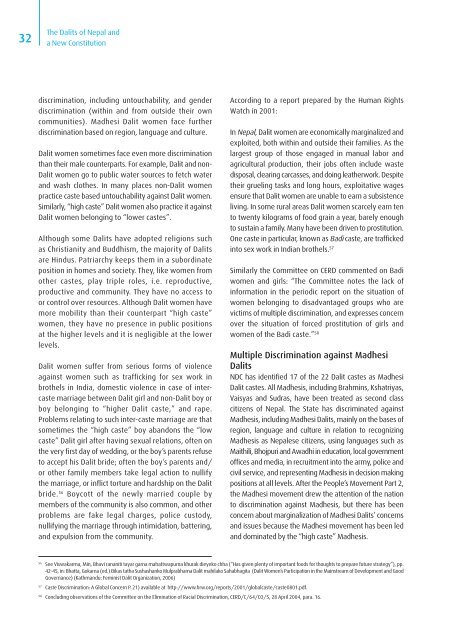The Dalits of Nepal and a New Constitution - ConstitutionNet
The Dalits of Nepal and a New Constitution - ConstitutionNet
The Dalits of Nepal and a New Constitution - ConstitutionNet
Create successful ePaper yourself
Turn your PDF publications into a flip-book with our unique Google optimized e-Paper software.
32<br />
<strong>The</strong> <strong>Dalits</strong> <strong>of</strong> <strong>Nepal</strong> <strong>and</strong><br />
a <strong>New</strong> <strong>Constitution</strong><br />
discrimination, including untouchability, <strong>and</strong> gender<br />
discrimination (within <strong>and</strong> from outside their own<br />
communities). Madhesi Dalit women face further<br />
discrimination based on region, language <strong>and</strong> culture.<br />
Dalit women sometimes face even more discrimination<br />
than their male counterparts. For example, Dalit <strong>and</strong> non-<br />
Dalit women go to public water sources to fetch water<br />
<strong>and</strong> wash clothes. In many places non-Dalit women<br />
practice caste based untouchability against Dalit women.<br />
Similarly, “high caste” Dalit women also practice it against<br />
Dalit women belonging to “lower castes”.<br />
Although some <strong>Dalits</strong> have adopted religions such<br />
as Christianity <strong>and</strong> Buddhism, the majority <strong>of</strong> <strong>Dalits</strong><br />
are Hindus. Patriarchy keeps them in a subordinate<br />
position in homes <strong>and</strong> society. <strong>The</strong>y, like women from<br />
other castes, play triple roles, i.e. reproductive,<br />
productive <strong>and</strong> community. <strong>The</strong>y have no access to<br />
or control over resources. Although Dalit women have<br />
more mobility than their counterpart “high caste”<br />
women, they have no presence in public positions<br />
at the higher levels <strong>and</strong> it is negligible at the lower<br />
levels.<br />
Dalit women suffer from serious forms <strong>of</strong> violence<br />
against women such as trafficking for sex work in<br />
brothels in India, domestic violence in case <strong>of</strong> intercaste<br />
marriage between Dalit girl <strong>and</strong> non-Dalit boy or<br />
boy belonging to “higher Dalit caste,” <strong>and</strong> rape.<br />
Problems relating to such inter-caste marriage are that<br />
sometimes the “high caste” boy ab<strong>and</strong>ons the “low<br />
caste” Dalit girl after having sexual relations, <strong>of</strong>ten on<br />
the very first day <strong>of</strong> wedding, or the boy’s parents refuse<br />
to accept his Dalit bride; <strong>of</strong>ten the boy’s parents <strong>and</strong>/<br />
or other family members take legal action to nullify<br />
the marriage, or inflict torture <strong>and</strong> hardship on the Dalit<br />
bride. 56 Boycott <strong>of</strong> the newly married couple by<br />
members <strong>of</strong> the community is also common, <strong>and</strong> other<br />
problems are fake legal charges, police custody,<br />
nullifying the marriage through intimidation, battering,<br />
<strong>and</strong> expulsion from the community.<br />
According to a report prepared by the Human Rights<br />
Watch in 2001:<br />
In <strong>Nepal</strong>, Dalit women are economically marginalized <strong>and</strong><br />
exploited, both within <strong>and</strong> outside their families. As the<br />
largest group <strong>of</strong> those engaged in manual labor <strong>and</strong><br />
agricultural production, their jobs <strong>of</strong>ten include waste<br />
disposal, clearing carcasses, <strong>and</strong> doing leatherwork. Despite<br />
their grueling tasks <strong>and</strong> long hours, exploitative wages<br />
ensure that Dalit women are unable to earn a subsistence<br />
living. In some rural areas Dalit women scarcely earn ten<br />
to twenty kilograms <strong>of</strong> food grain a year, barely enough<br />
to sustain a family. Many have been driven to prostitution.<br />
One caste in particular, known as Badi caste, are trafficked<br />
into sex work in Indian brothels. 57<br />
Similarly the Committee on CERD commented on Badi<br />
women <strong>and</strong> girls: “<strong>The</strong> Committee notes the lack <strong>of</strong><br />
information in the periodic report on the situation <strong>of</strong><br />
women belonging to disadvantaged groups who are<br />
victims <strong>of</strong> multiple discrimination, <strong>and</strong> expresses concern<br />
over the situation <strong>of</strong> forced prostitution <strong>of</strong> girls <strong>and</strong><br />
women <strong>of</strong> the Badi caste.” 58<br />
Multiple Discrimination against Madhesi<br />
<strong>Dalits</strong><br />
NDC has identified 17 <strong>of</strong> the 22 Dalit castes as Madhesi<br />
Dalit castes. All Madhesis, including Brahmins, Kshatriyas,<br />
Vaisyas <strong>and</strong> Sudras, have been treated as second class<br />
citizens <strong>of</strong> <strong>Nepal</strong>. <strong>The</strong> State has discriminated against<br />
Madhesis, including Madhesi <strong>Dalits</strong>, mainly on the bases <strong>of</strong><br />
region, language <strong>and</strong> culture in relation to recognizing<br />
Madhesis as <strong>Nepal</strong>ese citizens, using languages such as<br />
Maithili, Bhojpuri <strong>and</strong> Awadhi in education, local government<br />
<strong>of</strong>fices <strong>and</strong> media, in recruitment into the army, police <strong>and</strong><br />
civil service, <strong>and</strong> representing Madhesis in decision making<br />
positions at all levels. After the People’s Movement Part 2,<br />
the Madhesi movement drew the attention <strong>of</strong> the nation<br />
to discrimination against Madhesis, but there has been<br />
concern about marginalization <strong>of</strong> Madhesi <strong>Dalits</strong>’ concerns<br />
<strong>and</strong> issues because the Madhesi movement has been led<br />
<strong>and</strong> dominated by the “high caste” Madhesis.<br />
56<br />
See Viswakarma, Min, Bhavi rananiti tayar garna mahattwapurna khurak dieyeko chha (“Has given plenty <strong>of</strong> important foods for thoughts to prepare future strategy”), pp.<br />
42-45, in: Bhatta, Gokarna (ed.) Bikas tatha Sushashanko Mulprabhama Dalit mahilako Sahabhagita (Dalit Women’s Participation in the Mainstream <strong>of</strong> Development <strong>and</strong> Good<br />
Governance) (Kathm<strong>and</strong>u: Feminist Dalit Organization, 2006)<br />
57<br />
Caste Discrimination: A Global Concern P. 21) available at http://www.hrw.org/reports/2001/globalcaste/caste0801.pdf.<br />
58<br />
Concluding observations <strong>of</strong> the Committee on the Elimination <strong>of</strong> Racial Discrimination, CERD/C/64/CO/5, 28 April 2004, para. 16.








![g]k fnsf blntx? / gofF ;+l jwfg](https://img.yumpu.com/49483602/1/184x260/gk-fnsf-blntx-goff-l-jwfg.jpg?quality=85)



![+ljwfg;ef, /fHosf]k'g](https://img.yumpu.com/41604075/1/184x260/-ljwfgef-fhosfkg.jpg?quality=85)




